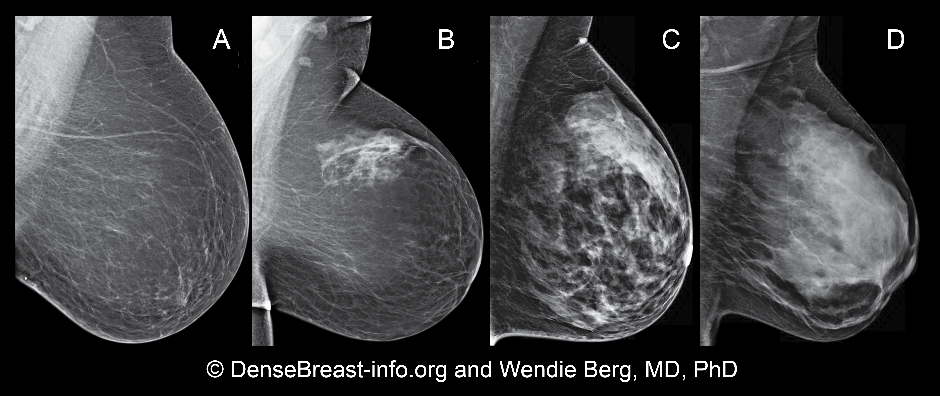
If you have had a mammogram before or are scheduled to get one, you’ve probably heard some about dense breasts. What does that mean, though? How do you know if you have dense breasts or not? Does this change the way you plan for your mammogram? Don’t worry – we have all the info for you!
1. Having dense breasts means you don’t have much fatty tissue in your breasts.
Aside from our glandular tissue, which makes up your milk ducts and glands, breasts are made up of two different types of tissue – connective and fatty. When women are young, they naturally have more glandular and connective tissue than fatty. As women age, however, and their bodies change, the ratio begins to skew towards more fatty tissue than glandular or connective. If you have dense breasts, that means you have more glandular and connective tissue than fatty tissue. This is a trait that can be genetic – if your mother has dense breasts, its likely that you may as well. In the photo above, the breast labeled A is the least dense and the breast labeled D is the most dense. You can see how these look very different.
2. The only way to tell if you have dense breasts or not is to have a mammogram.
Unfortunately, the only way to analyze the ratio of tissue in your breasts is for a radiologist to look at your imaging results from your mammogram! Even your doctor cannot determine this by the shape or feel of your breasts, or by any other factor. So if you have never had a mammogram before, you will find out when you have your first one! Having dense breasts is not uncommon – in fact, between 40-50% of women have dense breasts.
3. Imaging results of dense breasts can be more difficult for a radiologist to read.
Because of the way that mammograms display the tissue in your breast, breasts that are more dense are unfortunately harder to read. Look at the two photos below (thank you to Dense Breast Info for these!) As you can see, it’s much harder to spot the cancer in the dense breast image! What this means is that for many women with dense breasts, cancer is more difficult to detect.
4. But…. not to worry, there’s great news! New mammogram technology called hologic 3d mammography is improving reading outcomes for women with dense breasts.
3D mammography has recently been approved by the FDA to be more effective than 2D mammography for women with dense breasts. Because of the way that the imaging is done in a 3D mammogram, the radiologist gets many slides that show your breast tissue at different angles, making up a “3D” image of your breast tissue rather than just a single slide. This allows the radiologist to look much more closely at your tissue and makes finding cancerous spots much easier. If you’ve never heard of a 3D mammogram, check out our article about it! We describe in detail what the procedure is like.
Derry Imaging has also invested in Volpara Solutions, which provides an automated and precise assessment to inform women of their breast density. This information may be important as high breast density can increase a women’s risk for breast cancer.
5. You can book your 3D mammogram at Derry Imaging easily and affordably!
We believe that every woman has the right to the best care and technology possible, so we don’t charge any more for a 3D mammogram than a regular one. If your doctor has told you that you have dense breasts, book your 3D mammogram with us today so you can make sure you are getting access to the best technology available! Click here to learn all about 3D mammography at Derry Imaging, and click the button below when you’re ready to book your appointment online!


